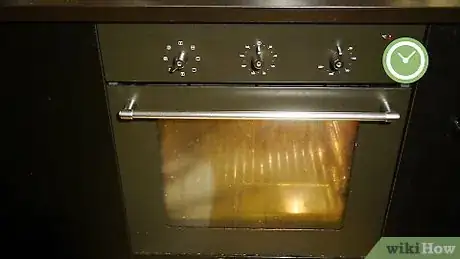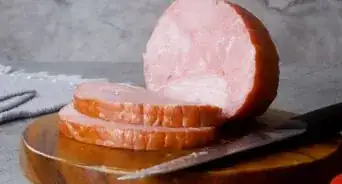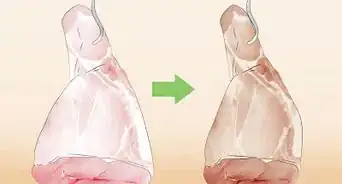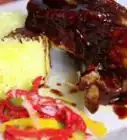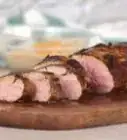This article was co-authored by Santos Aviles and by wikiHow staff writer, Megaera Lorenz, PhD. Santos Aviles is a Grill Master and the Owner of Spirit of Texas BBQ in San Bernardino, California. He specializes in Central Texas-style barbeque. He serves a variety of smoked, grilled, and roasted meats, including 14-hour smoked brisket, sausage, and other cuts of beef. Spirit of Texas BBQ is also a 5-star rated business.
There are 14 references cited in this article, which can be found at the bottom of the page.
This article has been viewed 51,675 times.
Baby back ribs (sometimes called “loin ribs”) are a cut of pork taken from the upper part of the ribcage, between the loin and the spare ribs. These delicious ribs are prized for their tenderness. You can achieve perfect baby back ribs by taking some time to season and tenderize them before slow-cooking them on the grill over indirect heat.
Ingredients
- 3–4 pounds (1.4–1.8 kg) of baby back ribs
- 1 or 2 limes
- Apple cider vinegar (as an alternative to limes), about 1⁄4 cup (59 mL) per 2 pounds (0.91 kg) of ribs.
- For a basic dry rub: 1 tablespoon (about 17 g) salt, and 1 tablespoon (about 7 g) each of black pepper and red pepper
- For a more complex dry rub: 1.5 tsp (6.25 g) of brown sugar, 1 tbsp (6.9 g) of paprika, 1.5 tsp (3 g) of fresh orange zest, 1.25 tsp (7.11 g) of salt, ¾ tsp (1.5 g) of cumin, ½ tsp (1.3 g) of ground black pepper, and ¼ tsp (0.65 g) of ground cayenne pepper
- Barbecue sauce of your choice
Steps
Tenderizing and Flavoring the Ribs
-
1Remove the thin membrane on the inside of the ribs. To prepare the ribs for grilling, begin by placing them on a clean, flat surface and turn them over so that the inner (convex) side faces up. Slide a sharp knife under the membrane on one end of the ribs to loosen an edge, then grab the loose corner and peel off as much of the membrane as you can. [1]
- You may find it helpful to grip the membrane with a piece of dry paper towel, since it tends to be a little slippery.
- If you want to grill with the membrane on, know that some professionals opt to do just that, since the membrane will melt into the bones when cooked at the right temperature.
-
2Rub the ribs with a cut lime. Take a lime and slice it in half. Squeeze the lime a little to release the juice as you rub the cut side over the ribs.[2] Depending on how juicy the limes are, you may need 1 to 2 limes to cover a full rack of ribs.
- The lime juice will penetrate into the meat of the ribs, both tenderizing the meat and infusing it with a zesty flavor.
- Alternatively, you can rub a little apple cider vinegar onto your ribs (use about 1⁄4 cup (59 mL) per 2 pounds (0.91 kg) of ribs).
Advertisement -
3Massage the ribs with a seasoning rub. Using the spice combination of your choice, rub dry seasonings all over your ribs. Make sure to cover every surface thoroughly. The rub will make the meat more flavorful and will also help seal in moisture as it cooks.[3]
- You can buy a pre-mixed rib rub or make your own. You can make a very basic rub by combining a tablespoon (about 17 g) of salt with 1 tablespoon (about 7 g) each of black and red pepper.
- For a more complex flavor, try mixing 1.5 tsp (6.25 g) of brown sugar, 1 tbsp (6.9 g) of paprika, 1.5 tsp (3 g) of fresh orange zest, 1.25 tsp (7.11 g) of salt, ¾ tsp (1.5 g) of cumin, ½ tsp (1.3 g) of ground black pepper, and ¼ tsp (0.65 g) of ground cayenne pepper. These ingredients will season 4 pounds (1.8 kg) of ribs.
-
4Wrap the ribs in plastic wrap and chill them for 8 hours. Once the ribs are infused with lime juice and spices, seal them up tightly with cling wrap. Put them in a covered baking dish and leave them in your fridge for at least 8 hours.[4]
- This will give the meat plenty of time to soak up the flavors from the lime juice and spices.
- You can safely let fresh pork ribs chill with the rub on them for 3 to 5 days.[5] However, the salt in the rub will eventually cause a loss of moisture and give the meat a “hammy” flavor. For the best flavor, try not to let the rub sit longer than around 12 hours.
- This step is optional if you're smoking your ribs.
Cooking the Ribs on the Grill
-
1Light one side of your grill and heat it to 350–400 °F (177–204 °C). For perfect baby back ribs, the best approach is indirect heat.[6] If you’re using a gas grill, only light the burners on one side. For a charcoal grill, move the charcoal to one side or put the coals around the edges of the grill so the center is open.[7]
- If your grill does not have a built-in thermometer, you can test the approximate temperature of the grill by holding the palm of your hand about 3 inches (7.6 cm) above the grate for a few seconds. If you can keep your hand there for 4 to 5 seconds before you have to pull it away, it’s around the right temperature.[8]
- If you’re not stacking the ribs, you may wish to cook them at a lower temperature (e.g., around 300–350 °F (149–177 °C)). At that temperature, you should be able to hold your hand above the grill for 6 to 7 seconds.[9]
- You can adjust the temperature of a charcoal grill by opening or closing the vents. Open vents will let in more oxygen, increasing the heat of the grill.[10]
-
2Place the ribs on the cooler part of the grill. When you’re ready to grill the ribs, remove them from their plastic wrap and lay them on the unlit side of the grill, bone-side down. Then, close the grill cover.[11]
- For extra tender ribs, stack your ribs on top of each other on the cool side of the grill. Let them cook for 40 minutes, then rotate the bottom rack of ribs to the top of the stack. Repeat this process 2 more times, rotating the ribs every 40 minutes.[12]
- Some barbecue chefs advise letting your meat sit at room temperature for at least 30 minutes before putting it on the grill so that the ribs cook more quickly and evenly.
-
3Baste the ribs with barbecue sauce as they cook. Once your ribs have been cooking for a couple of hours, brush some barbecue sauce on them. Let them cook for another 30 minutes or so, basting them occasionally.[13]
- If you stacked the ribs, you will need to separate them before adding the sauce. When you do this, turn the temperature of the grill down to low-medium heat, or between 300 °F (149 °C) and 350 °F (177 °C). This is necessary because the ribs will begin to cook more quickly once they’re separated.
-
4Cook the ribs until they are tender. The ribs are done when the meat is soft and separates easily from the bone. Once they’re ready, take them off the grill and let them stand for about 10 minutes before serving them.[14]
- Pork ribs need to be cooked to an internal temperature of at least 145 °F (63 °C) before you eat them.[15] This should happen long before the ribs reach their optimal tenderness.
- Your total cooking time should be around 2.5 hours.
-
5Slice up the ribs or serve them by the rack. Each rack will contain about 10 to 13 ribs. You can either divide the cooked racks into individual ribs or serve them in larger sections. If you’re serving your ribs up with sides (such as corn on the cob or potato salad), you can plan to serve up about 3-4 ribs per person.[16]
- Store any leftover ribs in a sealed container in your fridge for 3 to 4 days. For longer storage, put your ribs in a freezer-safe container and freeze them for up to 6 months.[17]
- To reheat your ribs, brush them with a fresh coating of barbecue sauce and wrap them well in aluminum foil. Place them in a baking dish and cook them in your oven for 30 minutes at 250 °F (121 °C).[18]
Community Q&A
-
QuestionWhat are the best ribs to grill?
 Community AnswerI think some meaty beef ribs would do well on a grill. Baby back or boneless ribs should cook faster on the grill; I would keep the grill temperature a little low to avoid overcooking because you don't want the ribs to be tough.
Community AnswerI think some meaty beef ribs would do well on a grill. Baby back or boneless ribs should cook faster on the grill; I would keep the grill temperature a little low to avoid overcooking because you don't want the ribs to be tough.
Things You’ll Need
- Sharp kitchen knife
- Plastic wrap
- Large baking dish with cover
- Grill
- Barbecue sauce brush
Expert Interview

Thanks for reading our article! If you'd like to learn more about cooking, check out our in-depth interview with Santos Aviles.
References
- ↑ https://www.southernliving.com/food/how-to/how-to-grill-baby-back-ribs
- ↑ https://www.southernliving.com/food/how-to/how-to-grill-baby-back-ribs?slide=239412#239412
- ↑ https://www.southernliving.com/food/how-to/how-to-grill-baby-back-ribs?slide=64742#64742
- ↑ https://www.southernliving.com/food/how-to/how-to-grill-baby-back-ribs?slide=64742#64742
- ↑ https://www.fda.gov/downloads/food/resourcesforyou/healtheducators/ucm109315.pdf
- ↑ https://www.southernliving.com/food/how-to/how-to-grill-baby-back-ribs?slide=239415#239415
- ↑ https://www.foodnetwork.com/recipes/food-network-kitchen/grilled-baby-back-ribs-3812069
- ↑ https://www.realsimple.com/food-recipes/cooking-tips-techniques/grilling/grill-temperature
- ↑ https://www.realsimple.com/food-recipes/cooking-tips-techniques/grilling/grill-temperature
- ↑ https://barbecuebible.com/2016/04/29/crash-course-4-ways-to-control-the-heat-on-a-charcoal-grill/
- ↑ https://www.foodnetwork.com/recipes/food-network-kitchen/grilled-baby-back-ribs-3812069
- ↑ https://www.southernliving.com/food/how-to/how-to-grill-baby-back-ribs?slide=239415#239415
- ↑ https://www.southernliving.com/food/how-to/how-to-grill-baby-back-ribs?slide=55043#55043
- ↑ https://www.southernliving.com/food/how-to/how-to-grill-baby-back-ribs?slide=6740#6740
- ↑ https://www.fsis.usda.gov/wps/portal/fsis/topics/food-safety-education/get-answers/food-safety-fact-sheets/meat-preparation/fresh-pork-from-farm-to-table/CT_Index
- ↑ https://www.realsimple.com/magazine-more/inside-magazine/ask-real-simple/ask-real-simple-how-many-ribs-should-be-served
- ↑ https://www.foodsafety.gov/keep/charts/storagetimes.html
- ↑ https://furiousgrill.com/best-way-to-reheat-ribs/
About This Article
To grill baby back ribs, start by preheating one side of your grill to 350-400 degrees Fahrenheit. Then, place the ribs on the cooler side of the grill and close the grill lid. Next, let the ribs cook for about 2 1/2 hours, or until they reach an internal temperature of 145 degrees Fahrenheit. As the ribs cook, baste them with sauce occasionally to give them flavor and prevent them from drying out. To learn how to prepare and season baby back ribs, keep reading!
